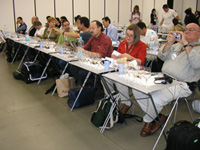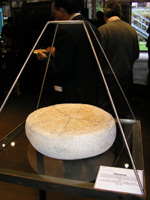|
(continua da "Slow food, fast genes... (1)" - continuing from "Slow food, fast genes... (1)")
Timescapes of authenticity
Innovation or creativity: which is the best concept for explaining the kind of novelty that affects our daily consumption of food? We can take innovation to mean "the improbable made real" (see Piero Bassetti's LSE lecture on Innovation, social risk and political responsibility; in italian: "Innovazione, rischio sociale e responsabilitÓ politica"). Unlike "creativity", innovation also implies the responsible (or irresponsible) use of technology to achieve such results. Food is one crucial arena in which such issues are coming to a crux, and are in need of new epistemological, moral and anthropological categories.
Between 21st and 25th October 2004, Turin hosted the Slow Food Salon of Taste, in its 5th biennial edition. The key-word was communities of food, and a parallel event "Mother Earth" hosted 5,000 representatives from small peasant communities from around the world, voicing their needs and networking amongst each other. Such events, and especially the Slow Food Salon, are accompanied by "food-tasting" sessions that aim at "educating" the public in the correct manners of appreciating good food.
 Il laboratorio del gusto "Strachitunt e Strachi Quader: la geometria della
Valtaleggio", tenutosi presso il Salone Internazionale del Gusto Slow Food,
Torino 21 ottobre 2004 | The workshop of good taste "Round and Square strachý: the geometry of
Valtaleggio", held at the International Slow Food Salon, Turin 21st October 2004 |
Nevertheless, the very project of food diversity and conservation is a sign of (post)modernity and the means by which such project is carried out include sophisticated media usage, legal tools and laboratory studies about the input of material culture on the quality of the produce, both in terms of nutritional contents and of organolectic characteristics. It also presumes an unprecedented reflexivity about the experience itself of food consumption. For instance, during the tasting workshop devoted to Valtaleggio's taleggio and strachitund, the participants were guided by a wine and a cheese expert through the experience of sniffing and tasting three types of taleggio cheese (fresh, seasoned and the Strachitund variant) with four different types of white and red wines. Headphones were provided for translation into English and many had a digital camera at hand. Considering how taleggio cheese is the peasant cheese par excellence, made by dairy herders "on the move" between one alpine pasture to another, with the milk made by their "tired cows" (strache, hence strachi') after long transfers on mountain trails, we can appreciate how far is the post-modern reconstruction of a culture of taste to its "traditional" origin.
Here, creativity is wholly devoted to the restoration of "tradition", and innovation is devoted to provide suitable frameworks for its consumption (tourism, food-tasting, ethno-cuisine etc.). Northern Italy clearly displays such peculiarity: here there are different and conflicting ways in which alpine and lowland cultures of food production and consumption engage in the skilled management of tradition, as they are confronted with the contemporary global market for ethno-foods in the new European legislative context. In the Alpine region food production intertwines intimately with tourism development and conservation issues. This reverberates on local practices of production, planning and self-presentation: local development seems to be bound to its capacity to produce a vision of locality and a discourse of taste that suits the expectation of tourists and deli customers. On the other hand, the standardisation of food production through protocols and quality labelling leads to a standardisation of taste. As a result, quality food is increasingly marketed through visual and narrative strategies (e.g. through the visualisation of "traditional alpine landscapes").

Un momento del "sentiero del gusto: presentazione di 14 prodotti
d'alpeggio", Convegno "ProAlp Italia/Francia Italia/Svizzera. La
cooperazione transfrontaliera per la valorizzazione degli alpeggi", tenutosi
a Torino il 29 ottobre 2004 nell'ambito dell'iniziativa "Alpissima.
L'alpeggio in cittÓ" | One moment of the "path of taste: introducing 14 high pasture products", at the conference "ProAlp Italy / France / Switzerland. Cooperation across boundaries for the promotion of the high pastures", held in Turin on October 29th 2004 as part of the event "Alpissima.
High pastures in the city" |
At its roots, though, the (post)modern domestication of the senses goes hand in hand with the domestication of marginal agriculture. While protocols of production discipline and standardise the everyday gestures of dairy breeders and cheese-makers in the name of hygiene and public safety, the sensibility of (post)modern customers shifts towards a marked commodification of taste - an experience that cannot be sold without proper visual "packaging". While EU hygiene regulations practically outlaw raw-milk dairy products of the alpine high pastures, the "poetics of authenticity" (Herzfeld 1992, 1999, 2004) ignores a marked standardisation of sensory experience, as an ethnographic analysis of taste can show.
Regaining a wider diversity of taste possibilities is often perceived as reaching the vantage point of skilled discernment over chaotic fluxes of commodities. Hence, unveiling the deep aspirations and the political subtlety of such trend means also testing the scope, aims and limits of the search for alternative methods of ensuring food safety and cultural conservation in the name of "traditional" and "indigenous" knowledge.
Paradoxically, "reinventing tradition" can ensure the survival of local recipes and skills. But at the same time it puts enormous strain on producers, distributors, local administrators and agricultural advisors to adapt local networks of production and local cultures of taste to both legal and rhetorical strategies for the commodification of locality. The regulation, publicity and politics of quality cheese impacts at the micro level on the everyday skilled practice of producers (who often coincide with local cattle breeders), technicians and administrators. In the small but complex contexts of the alpine region, conservation and development can go hand in hand but demand the "translation" of marginal agriculture into a globalised practice.
Hence local cultures of taste undergo lengthy and politically tricky processes to ensure quality certifications, media exposure and a market niche. This entails a momentous change at the local level of communities of practice, especially in alpine and rural areas, affecting the practice and rhetoric of small mountain communities. Conflict is a key element in the construction of taste as heritage, involving agricultural advisory bureaux, farmers trade unions, and breeders. For example, the production of a niche high-pasture cheese may well clash with the economic strategy of the farmers in a wider area. In fact, these may well be encouraged to produce more widely the same product in order to make the most of the high price and notoriety of the cheese in favour of the highest possible number of producers. This may clash with the philosophy of establishing small and tightly controlled productions in specific valleys or areas, where local historians can prove autochthonous traditions and geographical boundaries can be presided over.
Often, claims about "better" or "lower" quality of the cheese may be cursorily cast in geographical terms. But what are really at stake in the processes of self-appointment and social acknowledgement are genealogies (whether one belongs or not to a farming family who has been making one type of cheese) and patterns of movement (farmers who practiced transhumance may well have taken some mountain recipes with them).
REFERENCES
- Bassetti, P., 2003. Innovation, social risk and political responsibility, https://www.fondazionebassetti.org/02/docs/bassetti-lse-14may2003-engl.htm
Innovazione, rischio sociale e responsabilitÓ politica, https://www.fondazionebassetti.org/02/docs/bassetti-lse-14maggio2003.htm
- Herzfeld, M., 1992, The Social Production of Indifference: Exploring the Symbolic Roots of Western Bureaucracy, Oxford, Berg.
- Herzfeld, M., 1999, Cultural Intimacy. Social Poetics in the Nation-State, New York, Routledge.
- Herzfeld, M., 2004, The Body Impolitic: Artisans and Artifice in the Global Hierarchy of Value, Chicago, Chicago University Press.
- Strathern, M., 2000 (ed.) Audit Cultures: Anthropological Studies in Accountability and the Academy, London: Routledge.
|
 This Web space, edited by Cristina Grasseni , is dedicated to a survey of sites
and publications addressing the issues of innovation and responsibility. It
considers a number of "local" ethnographic issues and includes reflections
and ideas on the globalising aspects of innovation and responsibility
This Web space, edited by Cristina Grasseni , is dedicated to a survey of sites
and publications addressing the issues of innovation and responsibility. It
considers a number of "local" ethnographic issues and includes reflections
and ideas on the globalising aspects of innovation and responsibility
 Leggi la PRESENTAZIONE
Leggi la PRESENTAZIONE
 Read the INTRODUCTION
Read the INTRODUCTION

